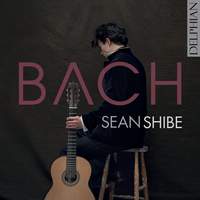Recording of the Week,
Sean Shibe plays Bach Lute Suites
Today’s Recording of the Week sees guitarist Sean Shibe devote a full album to early music for the first time: having previously paired the old with the new on Dreams and Fancies and softLOUD, he now dives fully into the old with an exploration of the enigmatic lute works of JS Bach. The three suites here may share consecutive BWV numbers but they in fact come from quite different periods in Bach’s career, and through Shibe’s sensitive playing it’s possible to discern the distinct personalities of the relatively youthful composer honing his craft and the mature master at the height of his powers.
 We open with the E minor Suite, BWV996, thought to date from Bach’s late 20s; while it adheres closely to the standard dance-suite formula from which Bach would later deviate in subsequent suites, it is anything but matter-of-fact. After a declamatory Prelude, a rippling Allemande and stately Courante, in the opening of the Sarabande we hear the first demonstration of a uniquely pearly pianissimo sonority that Shibe deploys at various key moments throughout the recording. The guitar is not known for its breadth of dynamic range, but Shibe shows clearly that it is perfectly possible to achieve great sonic variety, both in volume and in texture. This same tone-colour, almost harp-like in some places, returns in the fugue of the C minor Partita (BWV997) as well as at the beginning of the E flat major Fugue – here providing a deceptively self-effacing introduction to a movement that later flowers into a majestic, dignified musical statement. Naturally enough, it’s also in the fugues that Shibe’s clarity of playing is most on display, bringing out intricate contrapuntal parts as clearly as if each line was being performed by a separate musician.
We open with the E minor Suite, BWV996, thought to date from Bach’s late 20s; while it adheres closely to the standard dance-suite formula from which Bach would later deviate in subsequent suites, it is anything but matter-of-fact. After a declamatory Prelude, a rippling Allemande and stately Courante, in the opening of the Sarabande we hear the first demonstration of a uniquely pearly pianissimo sonority that Shibe deploys at various key moments throughout the recording. The guitar is not known for its breadth of dynamic range, but Shibe shows clearly that it is perfectly possible to achieve great sonic variety, both in volume and in texture. This same tone-colour, almost harp-like in some places, returns in the fugue of the C minor Partita (BWV997) as well as at the beginning of the E flat major Fugue – here providing a deceptively self-effacing introduction to a movement that later flowers into a majestic, dignified musical statement. Naturally enough, it’s also in the fugues that Shibe’s clarity of playing is most on display, bringing out intricate contrapuntal parts as clearly as if each line was being performed by a separate musician.
Dance-suites perennially pose a question to the performer of how much self-expression is permissible and how much the regularity of the dance-rhythms should be sacrificed to it. In general Shibe seems to lean towards keeping the pulse going – try the cascading Gigue of the E minor Suite or its lilting counterpart in the C minor Partita – and seems to take particular pleasure in the three-against-two rhythmic play of the former. At the same time, he still finds scope for the flexibility and human touch that brings the music fully alive. Even in the no-nonsense Bourrée of the E minor Suite – over in seventy brisk seconds – there’s still many an expressive nuance to be fleetingly savoured.
While both the first two suites are enjoyable works combining lightheartedness with profundity, there’s something about the final suite, BWV998 in E flat, that sets it apart. Here Bach completely abandons the dance-movements that dominated the other two suites, and the feeling of the music is different, with an indefinable breadth and depth that wasn’t perceptible before. It’s now suspected that this suite was originally written for the Lautenwerck (a keyboard instrument derived from the harpsichord, which approximated the sound of the lute), and this may be partly where that different mood originates from; but as Shibe amply demonstrates, its movements lose nothing from performance on the guitar. Quite the reverse, indeed; he achieves the seemingly impossible by successfully recreating something of the spirit of an expansive keyboard prelude. After the placid Prelude, the Fugue unfolds into a kind of stately grandeur, capped by a final Allegro that is nothing short of triumphant.
When I first read in the sleeve-notes that some of these works may have been performed in a sacred context, I'll admit I was sceptical – but on listening to this final suite in particular, I have come round to the idea more and more. I can only speculate as to what circumstances might make it necessary, but any of these movements would serve as a glorious closing voluntary in lieu of an organ work. The rich resonance of the open bottom string is particularly audible in this suite, presumably a happy consequence of the strings’ tuning lining up perfectly with the written key. Where elsewhere this might give a sense of open-mic-night intimacy, here it has the opposite effect; for me, it’s a subtle hint of the resonance of a church acoustic, and perfectly underscores the point made in the notes that 'sacred overtones' – no pun intended – 'are evident in all three works on this recording'.
Sean Shibe (guitar)
Available Formats: CD, MP3, FLAC, Hi-Res FLAC
Sean Shibe (guitar)
Available Formats: CD, MP3, FLAC, Hi-Res FLAC
Sean Shibe (guitar)
Available Formats: CD, MP3, FLAC, Hi-Res FLAC





